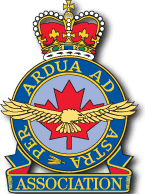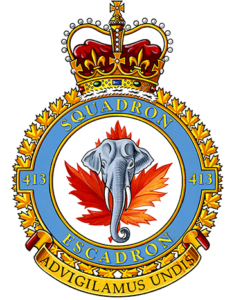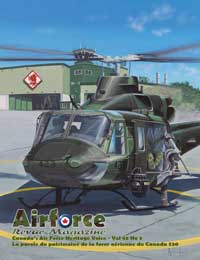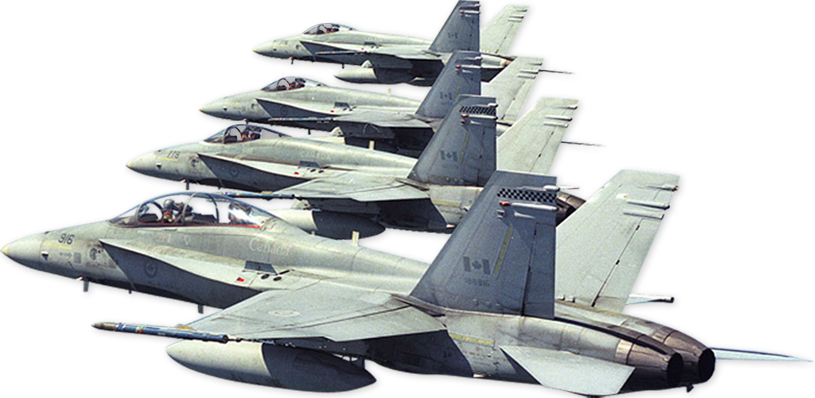 No. 413 Squadron
No. 413 Squadron
Badge: In front of a maple leaf an elephant’s head affronte
Motto: Ad vigilamus undis (We watch the waves)
Authority: King George VI, October 1943
The elephant head represents the squadron’s operations from Ceylon, while the motto suggests its functions.
Formed at Stranraer, Scotland on 1 July 1941 as the RCAF’s eleventh – third coastal and first flying boat General Reconnaissance – squadron formed overseas, the unit flew Catalina aircraft on north Atlantic reconnaissance and anti- submarine patrols. In March 1942, it was hurriedly moved to the Far East. As aircraft and crews arrived at Koggala, Ceylon, they were pressed into service making reconnaissance flights over the Indian Ocean to watch for the approach of a Japanese naval force. On 4 April, S/L L.J. Birchall, whose aircraft and crew had arrived in Ceylon only two days earlier, sighted and reported a large Japanese fleet 350 miles south of Ceylon. The Catalina (Mk.I AJ155 “A”) was shot down by Japanese carrier aircraft, and S/L Birchall and the survivors of his crew were taken prisoner, but their warning had alerted Ceylon’s defences and the Japanese attack was repulsed. (1) The squadron remained in Ceylon until early 1945, (2) was then returned to the United Kingdom for conversion to a Bomber unit, but was instead disbanded at Bournemouth, Hampshire on 23 February 1945.
Brief Chronology: Formed at Stranraer, Scot. 1 Jul 41. Disbanded at Bournemouth, Hants., Eng. 23 Feb 45.
Title or Nickname: ”Tusker”
Commanders
- W/C V.H.A. McBratney (RAF) 1 Jul 41 – 18 Aug 41.
- W/C R.G. Briese 19 Aug 41 – 22 Oct 41 KIA.
- W/C J.D. Twigg 15 Nov 41 – 19 Mar 42.
- W/C J.L. Plant 20 Mar 42 – 21 Oct 42.
- W/C J.C. Scott, DSO 22 Oct 42 – 20 Jun 43.
- W/C L.H. Randall, DFC 21 Jun 43 – 14 Sep 44.
- W/C S.R. McMillan 15 Sep 44 – 18 Feb 45.
Higher Formations and Squadron Locations
Coastal Command:
No. 15 Group,
- Stranraer, Scot. 1 Jul 41 – 30 Sep 41.
No. 18 Group,
- Sullom Voe, Shetland 1 Oct 41 – 3 Mar 42.
- En route to Ceylon 4 Mar 42 – 29 May 42.
- (First 4 aircraft arrived 2-4 Apr 42)
South East Asia Command:
No. 222 Group,
- Koggala, Ceylon 2 Apr 42 – 19 Jan 45.
- Detachments at Addu Atoll, Seychelles Is., Indian Ocean; Mombasa, Kenya; Bahrein, Persian Gulf; Langebaan, South Africa; Aden.
- En route to England (minus aircraft) 21 Jan 45 – 20 Feb 45·.
Bomber Command:
No. 6 (RCAF) Group (on paper only),
- Bournemouth, Hants. 21 Feb 45 – 23 Feb 45.
- (Officially transferred to Bomber Command 18 Feb 45, while still at sea, though “virtually non-existent” as a unit.)
Representative Aircraft (Unit code, UK only, QL)
Consolidated Catalina Mk.I, 1B & IV (Jul 41 – Dec 44)
- W8412 P W8421 D W8427 G W8434 F 22135 H 22149 V AH549 F AH550 L AH567 S AJ161 W FP182 G FP282 Y FP306 2 FP323 A JX276 Z JX280 A JX292 B JX299 V JX311 C JX321 D JX330 H JX333 F JX336 C JX357 V
- On 1 Aug 42, the following aircraft were relettered: W8412 P to B, W8421 D (3) , AH550 L to 2, AH567 S to C
Operational History: First Mission 6 October 1941, Catalina AH561 from Sullom Voe with F/L Thomas and crew – convoy escort; the convoy did not sail, and the aircraft was recalled.
Last Mission: 3/4 December 1944, 4 Catalinas from Koggala – hunt for a submarine reported at position 1237N 8840E; nothing was seen.
Summary Sorties: 871. Operational/Non-operational Flying Hours: 11,794/2783.
- Victories: U-boat: 1 possibly damaged; dropped 52 250-pound depth charges.
- Casualties:
- Operational: 3 aircraft; 27 aircrew were killed, missing or POW.
- Non-operational: 1 aircraft; 10 personnel, of whom 5 were killed, 5 died of other causes.
Honours and Awards: 1 DSO, 4 DFC’s, 2 AFC’s, 1 MiD.
Battle Honours:
- Atlantic 1941-1943.
- Ceylon 1942.
- Eastern Waters 1942-1944.
(1) S/L Birchall was awarded the DFC for his part in saving Ceylon from invasion, and later the OBE for his conduct while a prisoner of war. He also came to be known as the “Saviour of Ceylon.”
(2) It was also involved in reopening air service between Ceylon and Australia in May 1943, using a specially modified and stripped-down BOAC Catalina, FP244 G-AGFM. The first of three flights was made on 3 May by WIC Scott, who took 34 flying hours to reach Perth, and returned to Ceylon on 12 May. The second flight, under FIL R.W. Fursman, departed from Ceylon on 31 May and returned on 9 June; the third, under FIL P.A.S. Rumbold, departed 16 June and returned 26 June.
(3) This aircraft had previously belonged to No. 2 (GR) Squadron RAF and carried that unit’s code letters “AX”.





 No. 413 Squadron
No. 413 Squadron


